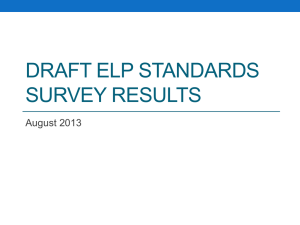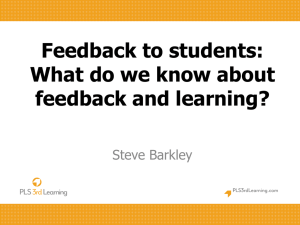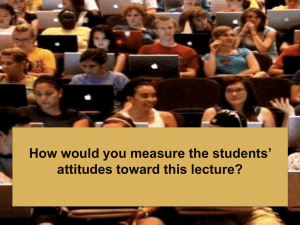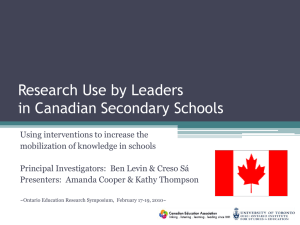Impact of class size on student engagement
advertisement
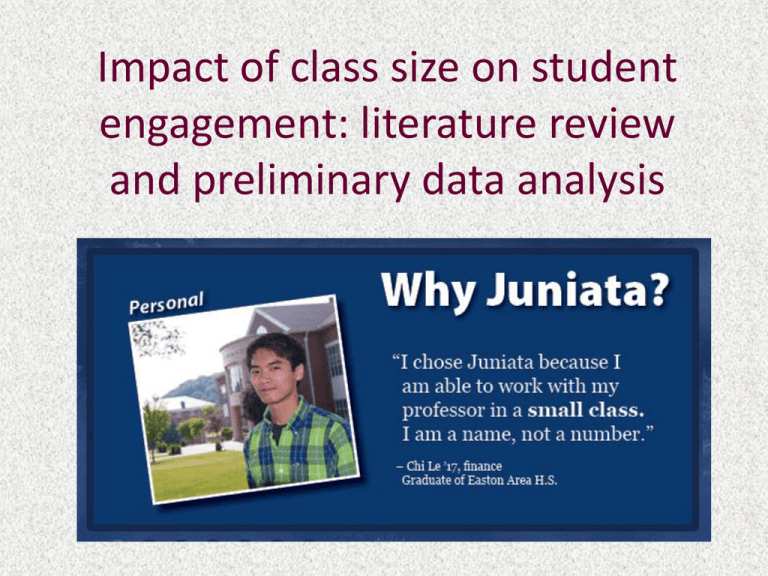
Impact of class size on student engagement: literature review and preliminary data analysis Advantages of a small class • • • • • • Knowing your students Easier to have discussion rather than lecture Number of assignments Exam type Larger classes may have lower attendance Easier to not respond in a large class Literature review The impact of class size on grades • Small better: Small class size has a positive effect on odds of getting a good grade (Scheck et al., 1994; Westerlund, 2006; Gibbs et al., 1996; Johnson, 2010) • No impact on grade due to class size (Hancock, 1996) • Large better: Students performed better in a large mega-section (150 students) than a small section (30 students) – the mega-section had additional technology tools, and an additional hour of small group meeting to cover problem solving and study skills (Brusi et al., 2013) • Effect of class size flattens as class size increases and almost ceases to exist when class reaches 50 for some disciplines. (Johnson, 2010) Exam scores, standardized test scores • Small better: Better final exam score for students in smaller course (Schattke and McAllister, 1962) • No impact of size (Arias and Walker, 2004; Baldwin, 1993; Bowling et al., 2008) • Large better: Students in large class outperformed small when attendance and GPA were taken into account (Hill, 1998) • Large better: Students in larger classes scored better on a standardized economics test (TUCE III) (Lopus and Maxwell, 1995) Long term retention, grades in future courses • Small better Students in a larger macroeconomics classed had lower grades in the second course than students in the small intro course (Raimondo et al., 1990) • No impact: Class size had no impact on the long term retention of material (Siegel et al., 1960; Siegfried and Kennedy, 1995), no impact on the proportion of students who changes majors (Baldwin, 1993), no impact on the grades in the next course or an intermediate level course (Baldwin, 1993), and no impact on the grade in a microeconomics sequence (Raimondo et al., 1990) • Large better: A larger proportion of accounting students in the large class continued into the next two classes (Baldwin, 1993) Experimental design What is the relationship between class size and student engagement in classes with greater than 30 students at Juniata College? Benefits of engagement • A pathway to success in college (Hu, 2011) for both performance and persistence (Gasiewski et al., 2012) • May have a more significant impact on lower achieving students, students of color (Kuh et al., 2008) and non-traditional students (Gilardi and Guglielmetti, 2011) • The lowest-ability students benefit more from engagement (Carini et al., 2006). • Positive (but weak) linkages between engagement, critical thinking and grades (Carini et al., 2006) Engagement • Behavioral engagement: participation in the classroom (attending class, paying attention, asking questions), extracurricular events, or social activities (Fredricks et al., 2004; Gasiewski et al., 2012). • Emotional engagement: a student’s feelings (positive or negative) to faculty, classmates, school (Fredricks et al., 2004), and their feelings of boredom, anxiety or excitement in class (Gasiewski et al., 2012). • Cognitive engagement: the student’s level of commitment to learning, including willingness to work hard to master the material (Fredricks et al., 2004). Study design • Survey students in classes of 30 and up. • List of courses generated by registrar, volunteers solicited. • Six different departments, all 100 or 200 level classes (THANK YOU!!) • Faculty provided information on teaching practices and perceptions of engagement • On-line survey given to students in that class between 11/1 and 11/21 Number of courses Results: classes 25 courses total surveyed Number of students enrolled in course Number of students Results: students 986 responses Number of students enrolled in course Graduation year Freshman Sophomore Junior Senior Number of students Results: graduation year Distribution within FSHN Disclaimers • Small sample size by class • No indication of cause and effect • Avoid over generalization 60-79 ≥80 Elective for distribution Elective in POE 40-49 Required for 2ndary Required for my POE Elective for distribution <40 students Elective in POE Required for 2ndary Required for my POE Elective for distribution Elective in POE Required for 2ndary Required for my POE Percentage of students in that size group Is this course required? 50-59 Engagement • Behavioral engagement: participation in the classroom (attending class, paying attention, asking questions), extracurricular events, or social activities (Fredricks et al., 2004; Gasiewski et al., 2012). • Emotional engagement: a student’s feelings (positive or negative) to faculty, classmates, school (Fredricks et al., 2004), and their feelings of boredom, anxiety or excitement in class (Gasiewski et al., 2012). • Cognitive engagement: the student’s level of commitment to learning, including willingness to work hard to master the material (Fredricks et al., 2004). Behavioral engagement I attend all the class sessions Strongly agree Strongly disagree Is there are relationship between class size and the amount of texting? Almost every class period Often Sometimes Never Similar pattern for e-mail, social media, and paying attention in class Behavioral engagement How often do you ANSWER questions posed by the instructor in class? Almost every class period Often Sometimes Never Behavioral engagement How often do you ASK the instructor a question in class? Almost every class period Often Sometimes Never Engagement • Behavioral engagement: participation in the classroom (attending class, paying attention, asking questions), extracurricular events, or social activities (Fredricks et al., 2004; Gasiewski et al., 2012). • Emotional engagement: a student’s feelings (positive or negative) to faculty, classmates, school (Fredricks et al., 2004), and their feelings of boredom, anxiety or excitement in class (Gasiewski et al., 2012). • Cognitive engagement: the student’s level of commitment to learning, including willingness to work hard to master the material (Fredricks et al., 2004). Emotional engagement I feel like the instructor cares about and supports my efforts to learn Strongly agree Strongly disagree Emotional engagement My instructor knows who I am (e.g., knows my name, recognizes me) Strongly agree Strongly disagree Emotional engagement I like my instructor Strongly agree Strongly disagree Emotional engagement Strongly agree Instructor cares about my learning Strongly disagree strongly disagree strongly agree Emotional engagement Strongly agree Instructor cares about my learning Strongly disagree strongly disagree strongly agree Emotional engagement I feel anxious or nervous about this class Strongly agree I feel anxious or nervous about this class Strongly disagree In this class, how often so you… Every Often Some Every Often Some Never Every Often Some Never Every Often Some Never feel angry? feel frustrated? laugh? Never Number of students feel bored? Never, Sometimes, Often, Almost every class Emotional engagement How often do you feel BORED in this class? Almost every class period Often Sometimes Never Emotional engagement How often do you feel ANGRY in this class? Almost every class period Often Sometimes Never Emotional engagement How often do you LAUGH in this class? Almost every class period Often Sometimes Never Emotional engagement How often do you feel FRUSTRATED in this class? Almost every class period Often Sometimes Never Emotions: relationships Almost every class period Often Sometimes Never strongly disagree strongly agree Emotions: relationships Almost every class period Often Sometimes Never Never Almost every class period Engagement • Behavioral engagement: participation in the classroom (attending class, paying attention, asking questions), extracurricular events, or social activities (Fredricks et al., 2004; Gasiewski et al., 2012). • Emotional engagement: a student’s feelings (positive or negative) to faculty, classmates, school (Fredricks et al., 2004), and their feelings of boredom, anxiety or excitement in class (Gasiewski et al., 2012). • Cognitive engagement: the student’s level of commitment to learning, including willingness to work hard to master the material (Fredricks et al., 2004). Cognitive engagement • I see the value in learning the material covered in this course • I consider myself a motivated student in this course • I attempted all assigned course work • I completed the required readings or preparatory assignments prior to class. Cognitive engagement I completed the required readings or preparatory assignments prior to class. Strongly agree Strongly disagree Does class size impact future interest in subject? Summary: relationship to class size • • • • • No relationship Amount of texting, social media and e-mail Attendance Boredom, anger, frustration Cognitive engagement Future interest in subject Relationship •Answer questions (upper limit) •Ask questions (-) •Instructor cares – limit on largest classes? •Knows my name (-) •I like my instructor (upper limit) •Anxiety (+ lower limit) Does class size influence teaching style? Teaching style and class size How often do you discuss questions with your peers in class? Almost every class period Often Sometimes Never Teaching style and class size How often do you discuss questions with your peers in class? Almost every How often class period do you interact with your peers to solve problems? Often How often do you discuss class related topics with your classmates DURING class? Sometimes Never Class time spent on lecture (%) Time in lecture vs class size 91-100% 81-90% 71-80% 61-70% 51-60% 41-50% 31-40% 21-30% 11-20% 0-10% Estimation by faculty How often do you feel bored in this class? Is lecture boring? Almost every class period Often Sometimes Never 0-10% 91-100% Summary: teaching style related to class size • There appears to be a limit to the amount of non-lecture used in large classes compared to medium classes. What’s next? More analysis of collected data • At risk individuals • Untangling relationships • Impact of field What mitigates potential negative effects of large classes? Collect more data? • Smaller class sizes • Spring classes • Additional years (replicates) Many thanks… The James J. Lakso Center for the Scholarship of Teaching & Learning Faculty who participated in the project Arias, J.J., Walker, D.M., 2004. Additional Evidence on the Relationship between Class Size and Student Performance. J. Econ. Educ. 35, 311–329. Baldwin, B.A., 1993. Teaching Introductory Financial Accounting in Mass-Lecture Sections: Longitudinal Evidence. Issues Account. Educ. 8, 97– 111. Bowling, B.V., Huether, C.A., Wang, L., Myers, M.F., Markle, G.C., Dean, G.E., Acra, E.E., Wray, Jacob, G.A., 2008. Genetic Literacy of Undergraduate Non–Science Majors and the Impact of Introductory Biology and Genetics Courses. BioScience 58, 654–660. Brusi, R., Portnoy, A., Toro, N., 2013. Student Engagement and Completion in Precalculus Precalculus Mega Section: Efficiently Assisting Student Engagement and Completion with Communications and Information Technology. J. Stem Educ. Innov. Res. 14, 20–25. Carini, R.M., Kuh, G.D., Klein, S.P., 2006. Student Engagement and Student Learning: Testing the Linkages*. Res. High. Educ. 47, 1–32. Fredricks, J.A., Blumenfeld, P.C., Paris, A.H., 2004. School Engagement: Potential of the Concept, State of the Evidence. Rev. Educ. Res. 74, 59– 109. Gasiewski, J., Eagan, M., Garcia, G., Hurtado, S., Chang, M., 2012. From Gatekeeping to Engagement: A Multicontextual, Mixed Method Study of Student Academic Engagement in Introductory STEM Courses. Res. High. Educ. 53, 229–261. Gibbs, G., Lucas, L., Simonite, V., 1996. Class size and student performance: 1984-94. Stud. High. Educ. 21, 261. Gilardi, S., Guglielmetti, C., 2011. University Life of Non-Traditional Students: Engagement Styles and Impact on Attrition. J. High. Educ. 82, 33– 53. Hancock, T.M., 1996. Effects of class size on college student achievement. Coll. Stud. J. 30, 479. Hill, M.C., 1998. Class size and student performance in introductory accounting courses: Further evidence. Issues Account. Educ. 13, 47–64. Hu, S., 2011. Reconsidering the Relationship Between Student Engagement and Persistence in College. Innov. High. Educ. 36, 97–106. Johnson, I.Y., 2010. Class Size and Student Performance at a Public Research University: A Cross-Classified Model. Res. High. Educ. 51, 701–723. Kuh, G.D., Cruce, T.M., Shoup, R., Kinzie, J., Gonyea, R.M., 2008. Unmasking the Effects of Student Engagement on First-Year College Grades and Persistence. J. High. Educ. 79, 540–563. Lopus, J.S., Maxwell, N.L., 1995. Teaching tools: Should we teach microeconomic principles bef. Econ. Inq. 33, 336. Raimondo, H.J., Esposito, L., Gershenberg, I., 1990. Research in Economic Education Introductory Class Size and Student Performance in Intermediate Theory Courses. J. Econ. Educ. 1986-1998 21. Schattke, R., McAllister, L., 1962. Large Versus Small Classes in Elementary Accounting. Account. Rev. 37, 557. Scheck, C.L., Kinicki, A.J., Webster, J.L., 1994. The effect of class size on student performance: Development and assessment of a process model. J. Educ. Bus. 70, 104. Siegel, L., Adams, J.F., Macomber, F.G., 1960. Retention of subject matter as a function of large group instructional procedures. J. Educ. Psychol. 51, 9–13. Siegfried, J.J., Kennedy, P.E., 1995. Does Pedagogy Vary with Class Size in Introductory Economics? Am. Econ. Rev. 85, 347–351. Toth, L.S., Montagna, L.G., 2002. Class Size and Achievement in Higher Education: A Summary of Current Research. Coll. Stud. J. 36, 253. Westerlund, J., 2006. Class Size and Student Evaluations in Sweden. Ssrn Work. Pap. Ser. Behavioral engagement Number of students How often do you text during class time? Never Sometimes Often Almost every class period Behavioral engagement Number of students How often have you checked e-mail during class time? Never Sometimes Often Almost every class period Behavioral engagement Number of students How often have you checked social media (Facebook, Twitter, etc.) during class? Never Sometimes Often Almost every class period Relationships Almost every class period Often Sometimes Never Never Sometimes Often Almost every class period Relationships Almost every class period Often Sometimes Never Never Sometimes Often Almost every class period Behavioral engagement Number of students I attend all the class sessions Strongly disagree Strongly agree Higher level learning skills • Theoretically, students were better trained higher level thinking skills in the smaller class size. Conclusion is based on significant difference in grade in upper level course dependent on class size for the macroeconomic sequence but not the microeconomic sequence. (Raimondo et al., 1990)


